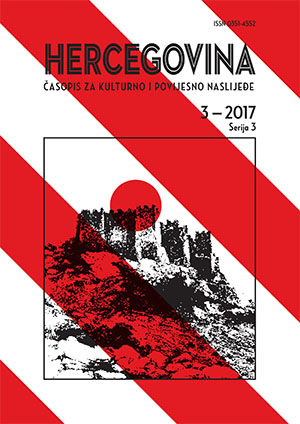CERNICA U DOBA KOSAČA
Cernica during Kosaca Reign
Author(s): Radmilo PekićSubject(s): History, Local History / Microhistory, 13th to 14th Centuries, 15th Century
Published by: Filozofski fakultet Sveučilišta u Mostaru
Keywords: Cernica; Kljuc; Kosaca; Sandalj Hranic; Stefan Vukcic; Dubrovnik;
Summary/Abstract: Based on the published and unpublished sources from the Dubrovnik archives, as well as earlier field research,the paper presents, apart from the references to the past,economic and cultural position of the Cernica residents during the reign of the noble Kosaca family.In the extant historiography medieval Cernica was recognized as one of the caravan stops on the 'Dubrovnik road'.Cernica was ruled by the squires from the house of Kosaca starting from the 70s of the 14th century until 1456, when it was incorporated into the Ottoman Empire. Duke Sandalj Hranic established the customs office in Cernica. As the time passed, Cernica became a trade centre. The marketand the main residential area were situated in the Cernicafield. Moreover, Cucenica, the place situated in the Cernica field, where medieval monuments were found, is even today referred to as Grad (town) or carsija (centre of the city) by the locals.One of the most important residences of the noble Kosaca family was a nearby fortified town called Kljuc, in which Kosaca dukes welcomed ambassadors and issued them charters. Sandalj Hranic and his heir Herzog Stefan Vukcic Kosaca controlled the road traffic that connected Dubrovnik with Bosnia and Serbia over Cernica and Kljuc. Merchants who used the 'Dubrovnik road' were robbed by the Kosaca's servantsin Cernica and its nearby area, often with the permission from their masters.The residents of Cernica were primarily involved in live stock farming and agriculture while some, to a lesser extent, were craftsmen. Surplus products from livestock farming and agriculture were exported to Dubrovnik.Due to preserved trade contracts which the residents from Cernica signed in Dubrovnik, we can conclude that their business associates were usually butchers and fabrics manufacturers and merchants. Therefore, the export from Cernica largely focused on livestock, wax and other raw materials, while the import consisted from different fabrics and other goods. Businessmen from Cernica usually bought goods taking loans from the Dubrovnik investors.Certain number of steles and sites of former churches are preserved as material remains from the medieval period. Steles from this area were removed and today they can be found at the museums in Sarajevo and Belgrade. A church,which was, according to the popular belief, built by Jelena Lazarevic, Sandalj Hranic's wife, has been excavated recently at the site of the orthodox cemetery in Makov Val.
Journal: Hercegovina. Časopis za kulturno i povijesno naslijeđe (Do 2018)
- Issue Year: 2017
- Issue No: 3
- Page Range: 69-98
- Page Count: 30
- Language: Serbian

